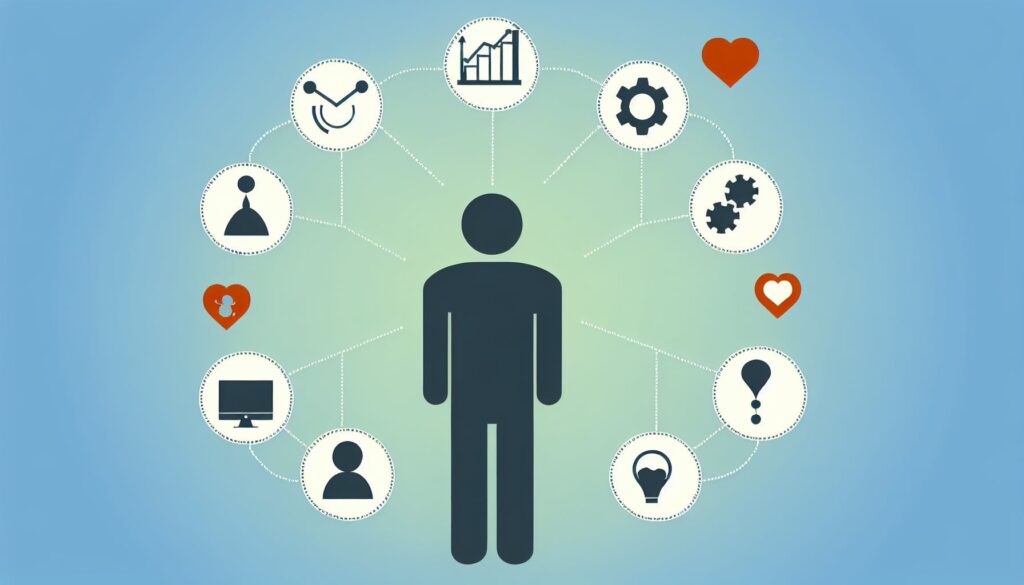Most people would agree that becoming a data analyst requires developing a diverse set of technical and analytical skills.
The good news is that with the right strategic approach, anyone can gain the essential qualifications needed to break into this rapidly growing field.
In this comprehensive guide, you’ll discover the fundamental skills required to pursue a career in data analysis, including statistical knowledge, programming proficiency, and data visualization techniques. You’ll also find actionable tips on how to acquire these skills efficiently through hands-on projects, certifications, networking, and more.
Pathways to Data Analysis
Becoming a data analyst requires a strategic blend of technical and analytical skills. As data permeates every industry, demand grows for professionals who can translate raw information into actionable business insights. This section explores pathways into the field for both experienced professionals and those just starting out.
What It Means to Be a Data Analyst
Data analysts occupy an essential role in the data value chain by cleaning, transforming, and modeling data to drive strategic decision making. Key responsibilities include:
- Structuring and standardizing data from various sources
- Running statistical analyses and data mining to uncover patterns
- Building data visualizations and dashboards to communicate insights
- Making recommendations to stakeholders based on analytical findings
Data analysts collaborate closely with teams across the business to understand objectives and decision factors. Both strong technical capacity and business acumen are required to distill data findings into plans that address real-world problems and opportunities.
Data Analytics in the New Economy
Data analytics has revolutionized modern business practices. As the world becomes increasingly digitized, companies rely on data to:
- Streamline operations and reduce costs
- Identify new market opportunities
- Personalize customer experiences
- Develop new products and revenue streams
- Outpace the competition
The ability to leverage data analytics confers a significant strategic advantage. Consequently, demand grows for data literate professionals who can translate raw information into meaningful insights using the latest tools and techniques.
Navigating the Field Without a Degree
Aspiring analysts wondering "How to become a data analyst without a degree?" have several solid options:
- Complete online courses or bootcamps in data analytics to build relevant skills
- Earn certificates from vendors like Google or IBM to demonstrate capabilities
- Highlight analytical projects in a portfolio to showcase hands-on experience
- Start in an adjacent role like business analyst to gain domain knowledge
While those with technical degrees have an edge for some positions, demonstrated aptitude, knowledge, and experience make non-degree pathways entirely viable.
Data Analyst vs. Data Scientist: Understanding the Distinction
Though related, data analysts and data scientists serve different primary functions. While analysts focus on descriptive and diagnostic analysis, scientists emphasize predictive modeling and machine learning. Key differences include:
- Purpose: Reporting vs. Forecasting
- Methods: SQL, Excel vs. Python, R
- Data: Structured vs. Unstructured
- Deliverables: Visualizations, Dashboards vs. Models, Algorithms
With overlapping capabilities, analysts can sometimes transition into data science roles after gaining more experience.
What qualifications do I need to be a data analyst?
To become a data analyst, you’ll usually need a bachelor’s degree or higher in a field like:
- Statistics
- Mathematics
- Economics
- Operational research
- Psychology
However, some employers may hire data analysts who demonstrate strong data analytics skills from work experience, even without a formal degree.
Here are some of the key qualifications you’ll need:
Technical Skills
- Proficiency in SQL, Python, R, Excel, Tableau, etc. These programming languages and tools are essential for querying, analyzing, visualizing and reporting on data.
- Statistical analysis skills like regression modeling, hypothesis testing, clustering algorithms, etc. You need to derive insights from data.
- Data modeling and database design experience to build databases and data pipelines.
Soft Skills
- Critical thinking and problem solving to design analysis approaches.
- Communication and presentation abilities to explain technical analysis to stakeholders.
- Creativity and curiosity to discover insights in data.
Certifications
Getting certified in data analytics can demonstrate your skills and give you a competitive edge. Some popular options include:
- Google Data Analytics Professional Certificate
- IBM Data Science Professional Certificate
- Microsoft Certified: Data Analyst Associate
With strong data analytics qualifications from education or experience supplemented by certifications, you can become a qualified data analyst. The key is showcasing technical proficiency in working with data.
How does it take to become a data analyst?
Becoming a data analyst can take between 3 months to 2 years depending on your background and dedication to acquiring the necessary skills. Here is a typical path to becoming a data analyst:
- Get a foundational education in Excel, statistics, SQL, and data visualization. This can be done through online courses, bootcamps, or a college degree program. Expect this to take 3-6 months.
- Build up your technical skills in SQL, Python, R, data visualization tools like Tableau, and cloud data platforms like AWS. Dedicate at least 3-6 months to get proficient.
- Work on real-world projects analyzing datasets from Kaggle or other sources. Applying your skills is the best way to prepare for a data analyst role. This can be an ongoing effort.
- Create a portfolio showcasing your projects and key skills. This will be vital for job applications. Plan to spend 1-2 months curating your best work.
- Practice presenting data-driven insights through reports, dashboards, and presentations. Communication skills are highly valued in data analytics.
- Start applying for entry-level data analyst jobs once you have developed enough skills and have portfolio work to showcase (typically 6 months minimum).
- Consider getting certified in SQL, Tableau, Power BI or other platforms to validate your skills. Many employers value certification. An advanced degree like a Master’s can also help fast track your career.
The key is dedication through self-directed learning and project work. With focus it’s realistic to have the skills needed to start an entry-level data analyst job within 6-12 months. Continuing to build expertise through work experience then opens doors to more advanced roles.
How long does it take to become a certified data analyst?
Becoming a certified data analyst can take between 4 months to 4 years depending on your starting point and program choice.
For those beginning with no prior experience, a dedicated data analytics bootcamp or certification program would be the fastest path, often taking around 4-6 months to complete. These intensive, skills-focused programs provide all the core training needed to prepare for data analyst roles.
Key elements covered include:
- Statistical analysis and data modeling
- SQL and database skills
- Data visualization and presentation
- Python or R programming
- Excel analysis
- Machine learning
By dedicating yourself full-time to such a program, you can gain job-ready data skills within months. However, you trade the depth of understanding and analytical maturity fostered via lengthier academic routes.
For beginners seeking more extensive training, a university degree in data science or analytics is an alternative option. This route involves:
- 2 years for a master’s degree
- 3-4 years for a bachelor’s program
- Or even 1-2 further years for a PhD
Though it takes considerably longer, these programs deliver rigorous grounding in statistical theory, research methods, analytics, and data handling. This equips you with deeper expertise to tackle more advanced analysis. However, you would still require supplementary self-study in tools like Python and SQL.
Overall, the path to becoming a certified data analyst can take between 4 months and 4 years depending on your goals and priorities. Dedicated bootcamp programs offer the fastest progression into entry-level roles. But advanced degrees build more robust analytical capabilities for handling complex modeling and statistical analysis.
How do I get a data analyst job with no experience?
Getting a data analyst job with no prior experience can seem daunting, but it is achievable by developing relevant skills, gaining hands-on practice, building your portfolio, networking, and leveraging online learning platforms.
Here are some practical tips:
Acquire Data Analysis Skills
- Learn SQL, Python, R, Excel for data manipulation and analysis
- Understand statistical concepts like distributions, significance testing
- Learn machine learning techniques like regression, clustering
- Study data visualization best practices
Dedicate time to learning fundamental concepts even before having work experience. Online courses, tutorials, documentation are great for self-education.
Gain Hands-On Experience
- Find public datasets online to analyze as practice
- Use tools like Tableau Public, Google Data Studio to create visualizations
- Contribute to open source projects involving data analysis
- Complete case studies to demonstrate analytical skills
Hands-on application reinforces skills and provides examples for your portfolio.
Build a Portfolio
Create a professional portfolio highlighting data analysis projects.
Include:
- Descriptions of business questions, data, and insights
- Code samples showcasing techniques used
- Interactive dashboards and visualizations
Having a solid portfolio proves capabilities even without work experience.
Network and Seek Internships
- Attend local data science meetups to connect with professionals
- Reach out to companies for informational interviews
- Apply for data analyst internships to gain initial experience
Leverage personal connections for advice and opportunities. Internships provide workplace training.
Use Online Learning Platforms
Take specialized certificate courses like:
- IBM Data Science Professional Certificate
- Google Data Analytics Certificate
Certificates verify skills and understanding of real-world practices.
With the right strategic approach, it’s possible to break into data analytics without previous job experience. Stay determined!
sbb-itb-0c864d8
Essential Data Analyst Technical Skills
Delve into the specific technical competencies that form the foundation of a data analyst’s skill set.
Mastering Statistics for Data Analysis
Statistics provides the mathematical foundation for analyzing and interpreting data. As a data analyst, having a solid grasp of statistical concepts is essential. This includes understanding probability, regression analysis, hypothesis testing, and more.
For example, probability helps analysts quantify uncertainty and make data-driven predictions. Regression analysis allows modeling of relationships between variables. Hypothesis testing enables analysts to draw conclusions from datasets.
Mastering statistics takes focused study and practice. Numerous online courses and certifications are available, like IBM’s Data Science Professional Certificate. Hands-on application using tools such as R, Python, or Excel to reinforce statistical methods is also vital.
SQL Proficiency: Accessing and Managing Data
SQL (Structured Query Language) skills enable analysts to retrieve and manipulate data stored in databases. Queries allow filtering, sorting, joining of tables, and more.
For instance, complex datasets often reside in relational databases. By constructing SQL queries, analysts can extract, transform, and load relevant data into other tools for further analysis.
SQL programming forms the backbone of data access and management. Resources like Codecademy’s Learn SQL course provide extensive hands-on practice. Through regular usage and query writing, analysts build SQL proficiency.
Python Programming: An Analyst’s Toolkit
Python has become the lingua franca of data science with its extensive libraries tailored for data tasks. As an open-source language, Python is free to use and has vast community support.
Libraries like Pandas and NumPy equip analysts with specialized functionality for data manipulation, modeling, and analysis. Matplotlib and Seaborn enable both simple and sophisticated data visualizations. Scikit-learn provides machine learning capabilities.
Through online platforms like DataCamp or Dataquest, analysts can systematically build Python fluency. Real-world practice analyzing datasets cements proficiency over time. Python skills greatly expand an analyst’s capabilities.
Data Visualization Techniques
Effective data visualization conveys complex findings simply and impactfully. As the common saying goes: "A picture is worth a thousand words."
Tools like Tableau, Power BI, and D3.js provide extensive functionality for crafting interactive dashboards, plots, and data stories. Analysts learn visual best practices like appropriate use of charts, colors, and layouts.
Sharpening data visualization skills takes hands-on work with tools and datasets. Public Tableau dashboards provide abundant examples to reverse engineer. Online courses, communities, and design resources offer continual learning.
Data Cleaning and Preparation: The First Steps in Analysis
Real-world data is often messy, with issues like missing values or inconsistencies. Cleaning and preparing raw data for analysis is crucial.
In Python, Pandas and NumPy provide data wrangling capabilities. Tasks involve handling missing data, detecting anomalies, standardizing formats, joining data sources, and more.
Mastering data preparation patterns takes repeated practice across diverse datasets. But this diligent work provides the clean foundation on which the entire analysis rests.
Acquiring Data Analyst Skills with No Experience
Explore avenues to develop data analyst skills for individuals starting from scratch.
Introduction to Data Analytics: Building Foundations
For those new to data analytics, starting with core fundamentals is key. Consider taking introductory online courses in data analysis, statistics, Python programming, and SQL to build critical foundations. Resources like Data Science in the New Economy on edX provide a high-level overview of key data analytics concepts and tools. Build competency using resources focused on beginners before progressing to more advanced material.
Certification Programs: Google and IBM Pathways
Structured certification programs like the Google Data Analytics Professional Certificate and IBM Data Analytics with Excel and R Professional Certificate on Coursera are an excellent option, even for those with no prior experience. These programs teach in-demand data analyst skills like data cleaning, visualization, and analysis using tools like Excel, R, SQL, Tableau and more. Certification signals competence to employers.
Learning by Doing: Hands-on Projects and Case Studies
Supplement coursework with real-world projects and case studies. Resources like DataCamp offer guided projects in Python, R, SQL and Excel that provide hands-on practice. Recreate analyses from public datasets and case studies to become comfortable applying skills. Document projects in a professional data analyst portfolio.
Networking and Mentorship
Connect with the data analytics community by networking and seeking mentorship. Attend local tech events, conferences like ODSC and join groups like Women in Data Science to meet peers. Ask to shadow an experienced data analyst or set up informational interviews to gain insights from their journey. Use these connections to learn industry best practices.
Building a Career as a Data Analyst
Becoming a data analyst requires dedication and continuous skill development. While formal education can provide a solid foundation, focusing on real-world skills and experience is key for career advancement.
Educational Pathways: Degrees and Continuous Learning
Pursuing a bachelor’s or master’s degree in a quantitative field like statistics, computer science, or data science can be beneficial. Programs like a data science degree online teach core competencies like statistical analysis, data modeling, Python programming, and machine learning.
However, applied skills and hands-on experience are equally critical. Lifelong learning through avenues like online courses, certifications, and hands-on practice is essential for staying current with the latest tools and techniques. Resources like the Google Data Analytics Professional Certificate help develop proficiency.
The combination of formal education and continuous self-directed learning provides the best preparation for a data analyst career.
How to Build a Data Analyst Portfolio: Tips for Success
A portfolio highlights real-world experience applying analysis skills. Effective portfolios showcase 3-5 projects demonstrating key abilities like:
- Data cleaning and preparation
- Exploratory data analysis
- Statistical modeling and machine learning
- Data visualization and presentation
Each project should detail the business context, analysis approach, tools utilized, and insights delivered. Include code, visualizations, presentations, and recommendations.
Portfolios prove both technical competence and ability to deliver business value. They demonstrate applied skills beyond degrees and certifications.
The Timeline: How Long Does It Take to Become a Data Analyst
With focused effort, it typically takes 6-12 months to develop the baseline skills needed to start an entry-level data analyst role. However, mastery occurs over years. Plan for:
- 3-6 months to gain core skills in Excel, SQL, and data visualization tools
- 6-12 months to add proficiency in Python and statistical analysis techniques
- 1-2 years of professional experience to refine abilities and progress beyond junior roles
Be patient, persistent, and proactive in seeking growth opportunities.
Preparing for the Job Market: Resume and Interview Strategies
An effective resume summarizes technical proficiencies, tools, methodologies, and project experiences. Emphasize contributions and business impacts over just tasks.
Interview preparation should include practicing responses to common questions on statistical concepts, analysis approaches, and past problem-solving examples.
Be ready to discuss technical skills and tools as well as demonstrate analytical thinking during the interview process.
Staying up-to-date on industry trends and mastering in-demand abilities is key for long-term employability.
Advanced Skills and Specializations
As a data analyst, having a strong foundation in essential skills like statistics, SQL, and data visualization is critical. However, developing expertise in additional areas can set you apart and open up opportunities in specialized roles.
Data Modeling and Analysis Tools
Mastering advanced data modeling techniques and tools like:
- Relational databases and schema design
- Statistical programming languages like R and Python
- Data analysis software like Tableau, Qlik, MicroStrategy
- Notebook environments like Jupyter
can equip you to take on more complex analytics challenges. These skills allow you to wrangle large, messy datasets, build predictive models, and create interactive dashboards to uncover impactful insights.
Gaining proficiency here demonstrates you can "speak the language" of various data systems and manipulate data programmatically. This expands the problems you can solve and types of analysis you can provide.
Machine Learning: A Step Towards Advanced Analytics
While early in your career you may focus more on reporting and visualization, data analysts are increasingly expected to have awareness of machine learning techniques like:
- Regression
- Classification
- Clustering
- Neural networks
Having exposure in this area, even at a basic level, helps you:
- Understand how predictive models work
- Identify situations where they would add value
- Interpret and explain model outputs
- Support data scientists in development and monitoring
This knowledge becomes indispensable as organizations shift towards automated, intelligent analytics.
Business Intelligence Analysts: Bridging Data and Strategy
Business intelligence (BI) analysts play a key strategic role, using data to guide business objectives. Their responsibilities can include:
- Identifying KPIs and metrics to track
- Designing data architecture to support analysis
- Translating analytics into plans and recommendations
Getting BI experience helps you connect the dots between raw data, analysis, and real-world actions. This skillset is hugely valuable for driving data-based decision making.
Data Analytics with Python: Use Case Demo
Python is becoming essential for data analysts due to its flexibility and scalability for working with data.
Here is an example analysis using Python and Pandas to solve a business issue:
The Scenario: A retailer wants to optimize its email marketing strategy to target customers most likely to convert.
The Approach
- Import customer email list into a Pandas DataFrame
- Add columns showing past purchase history and product categories
- Use
.groupbyand aggregation to analyze trends - Build a linear model predicting conversion rate
- Identify customer segments with highest conversion potential
This demonstrates how Python enables automation, statistical modeling, and data manipulation – all extremely useful for production analytics challenges.
These are just a few of the many specializations to consider. Continuing to expand your skills makes you a well-rounded analyst who can grow into senior, lead, or management roles.
Conclusion: The Data Analyst’s Roadmap
Recap of Data Analyst Skills and Qualifications
To become a data analyst, you need to develop expertise across several key areas:
- Statistical knowledge: Having a solid grasp of statistics allows you to understand and interpret data meaningfully. This includes skills like hypothesis testing, regression analysis, and predictive modeling.
- Programming: Languages like Python and R are essential for cleaning, manipulating, analyzing, and visualizing data programmatically. SQL is also critical for extracting data from databases.
- Data visualization: Creating impactful graphs, charts, and dashboards to communicate insights effectively. Tableau and Power BI are common data visualization tools.
- Data wrangling: The process of structuring, cleansing, and reformatting raw data to prepare it for analysis. Strong data wrangling skills are vital for working with real-world data.
- Domain knowledge: Understanding the business context around the data is key to delivering relevant insights. Having industry/subject matter expertise helps inform data analysis.
- Communication: Being able to convey technical findings clearly to stakeholders is crucial. Data analysts need to "translate" data insights into actionable business recommendations.
Continued Growth and Learning
Data analytics is an rapidly advancing field. To stay competitive, pursuing ongoing education is essential:
- Take additional courses to expand your skillset. Consider specializations like machine learning, big data analytics, business intelligence, etc.
- Follow industry blogs, podcasts, and publications to stay on top of the latest technological developments.
- Join professional organizations and attend conferences to connect with the data community.
- Take on side projects, Kaggle competitions, and hackathons to gain practical experience.
- Consider obtaining professional certifications from vendors like Google, IBM, Microsoft, etc. to validate and signal your skills.
Next Steps: From Learning to Earning
Once you have developed core data analytics competencies, focus on finding employment and building your career:
- Create a portfolio highlighting your projects and key skills to showcase to employers.
- Revamp your resume to emphasize relevant data analytics experience, tools, and domain knowledge.
- Search online job boards for data analyst openings at companies you’d like to work for.
- Leverage professional connections and LinkedIn to uncover unlisted opportunities.
- Prepare for interviews by practicing discussing your past data analysis work.
With perseverance and continued upskilling, you can realize your goal of becoming a professional data analyst.
Related posts
- Path to Become Data Analyst: Core Skills Uncovered
- Skills Required to Become a Data Analyst: Your Ultimate Guide
- Requirements to Become a Data Analyst: Core Skills
- How to Become a Professional Data Analyst: Essential Skills Mastery

Tech Writer | Data Analyst | Digital Creator



